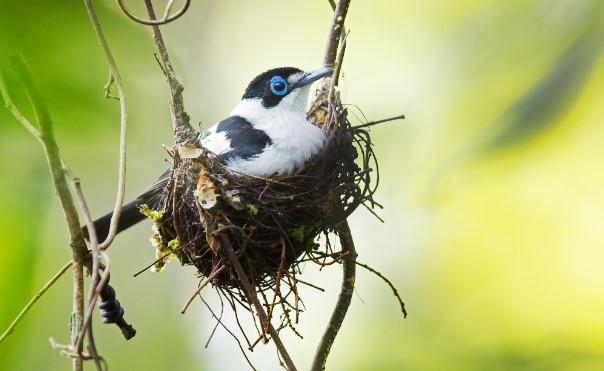The frilled monarch (Arses telescopthalmus) belongs to the family Monarchidae. In its habits of calling and feeding, the Frilled Monarch resembles the Pied Monarch, which it replaces in the rainforest galleries of the Cape York Peninsula. It is also known as the frill-necked flycatcher and the white-lored flycatcher. Its size measures 140–160 mm long.
Further, in the same way, the Pied Monarch, spirals up, down, and around tree trunks and branches, gleaning insects from near the ground into the canopy. It often also picks up prey attached to leaves by working its way through the outer foliage. To catch flying termites, it flies out with other birds in mixed flocks. When singing, it makes short whirring flights from twig to twig.
There is only a slight difference in the head patterns between Frilled Monarchs and Pied Monarchs in Australia, and they both forage the same way. The female frilled flycatchers of New Guinea are brown and russet-breasted, and unlike pied males, they feed primarily among canopy foliage. Frilled Monarch calls a frog-like squawk when feeding and constant buzzing and creaking. However, Frilled Monarch’s song consists of a sequence of short, high-trilled whistles.
Both sexes are a little different. The male head is glossy black, along with a white erectile ruff. The back, wings, and tail are glossy black, with a broad white band across the lower back to the scapulars and wing coverts. Also, there is a large black chin spot; the rest of the underparts are white. Eyes are dark brown; naked skin and round eyes are cobalt blue.
The bill is blue-grey with a dark tip. The feet are slaty. Female birds have white lores and chins; their ruffs are reduced. They are immature as adults but much duller: black areas dark gray tinged with brown, chin and lores white, ruff heavily flecked grey, underparts grey-white. Juveniles have washed russets on the mantle and wings. The Frilled Monarch resembles the Pied Monarch in appearance and habits but lacks a black breast band.
Nesting and breeding occur in September–January, perhaps longer. a cobweb-bound nest made of loosely woven baskets of plant stems and rootlets. The nest is decorated with fiber and lichen, slung between vines two to ten meters above the ground.
Frilled Monarch lays two eggs, which are slightly glossy, pale pink, freckled with red-brown, chestnut, and faint purple-grey, particularly at the larger end; oval shape, approximately I9 x I4 mm. Frilled Monarchs are found in coastal rainforests and their edges on the Cape York Peninsula, south to the Endeavour River, Queensland.
Read More: 30 Most Beautiful Finches in Asia










